Transplanting a Juniper tree into a new space [Bonsai]
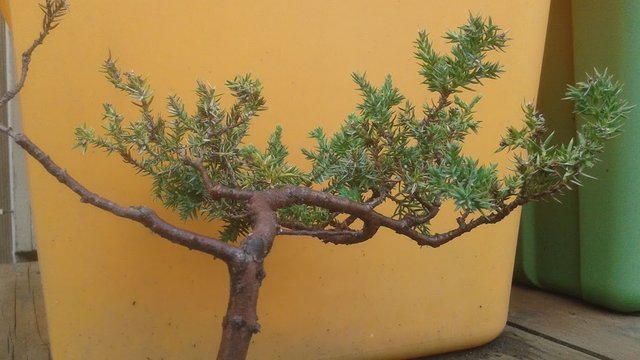
Sit down and relax beside me as I hone my skills in transplanting this surreal bonsai tree into a new clay pot.
In this post I will show photos of every step in the process. Everything from preparing the pot, uprooting the tree, filling the soil, securing the tree, and a final closer look at the tree's finer details.
Historical Info
ID: 0009
Nickname: Allison (alt: Maleficent)
Type: Juniper
Age: 5 years?
Grown: purchased from nursery
Last repotting: November 7, 2018. Previously spring 2016?
Wired: Never
Past posts featuring this tree:
Sometimes I call this tree Maleficent if it's needles are pricking my fingers. Today it was giving me more friendly wisdom and beauty without much pain, so I call it Allison (the girlfriend of Daniel Son in The Karate Kid).
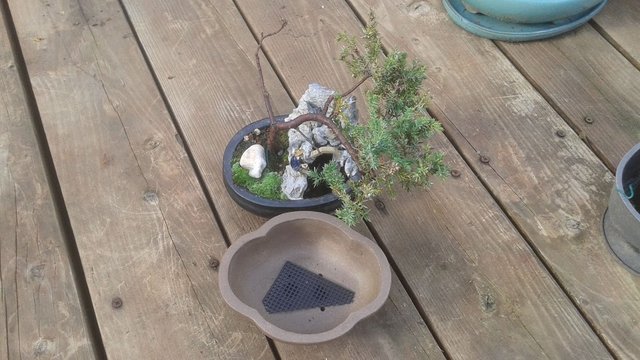
As you can see, this tree has lived quite the cramped lifestyle. Although it survives in a very whimsical pot complete with a side pond, a rock mountain, and a fisherman. This tree has not been showing strong signs of growth or vigor over the past year. It needs better soil and more space for the roots to grow strong.
This new un-glazed clay pot should allow plenty more space and oxygen into the roots.
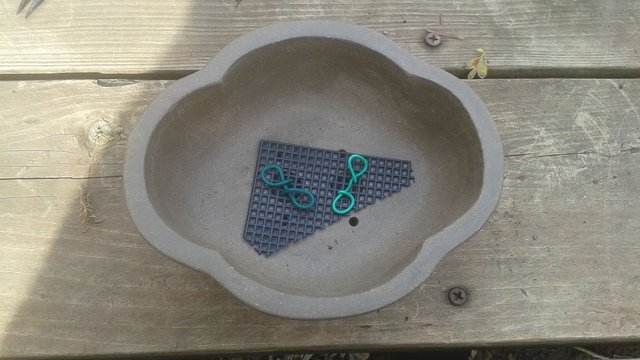
With wires, I form the "staples" to secure the screen. The screen will prevent the soil from spilling out the bottom, yet allow water to drain easily.
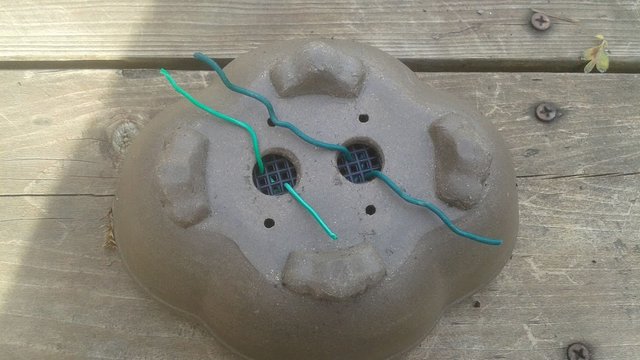
Underneath, I show how the wires can be stretched out to hold the screen in place. Excess wire can be trimmed with wire cutters.
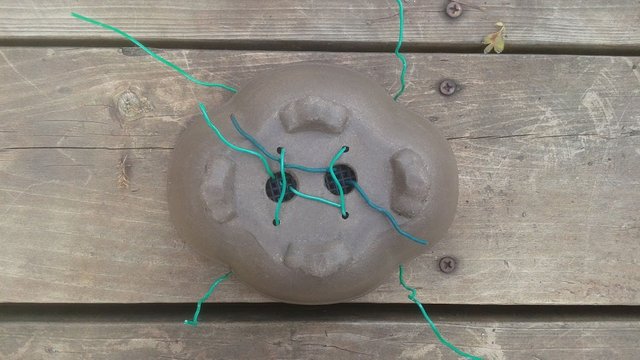
One feature about this pot that is unique is the wire holes. This if my first bonsai pot with wire holes. These holes are used for adding wires to secure the tree firmly against the pot so it does not move or tip over. This is especially useful to me knowing that I have rodents that will often try to dig and rip my plants and trees out from the soil.
Advanced wiring techniques to change the shape of the tree can also take advantage of these wire holes to form the shape of the tree using the strength of the pot as a foundation to secure to. I am not interested in changing the shape of this tree today using wires, as it already has a nice natural design I appreciate.
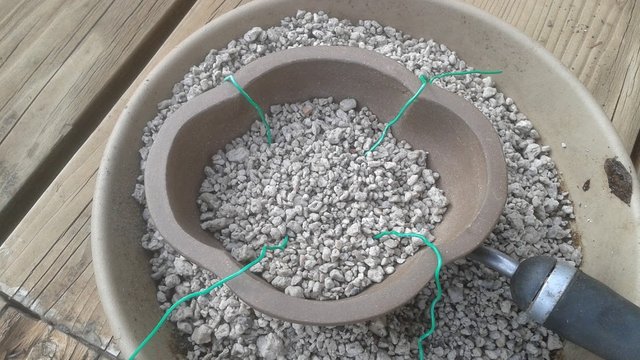
Horticultural pumice is used 100% a my chosen soil for this tree. The local rock landscaping store sold me a five gallon bag for $14, which I think is a bargain.
Pumice is an excellent growing medium because it is inorganic, and naturally formed volcanic rock, so it will never break down. It is lightweight and extremely porous due to the bubbly nature of the rock when it melted and dried from the volcanic process.
Juniper prefers a more desert-like soil that does not retain water, but does hold humidity, and pumice is perfect for that. Having a white soil to reflect the sunlight will also help keep the root temperatures lower in the summertime.
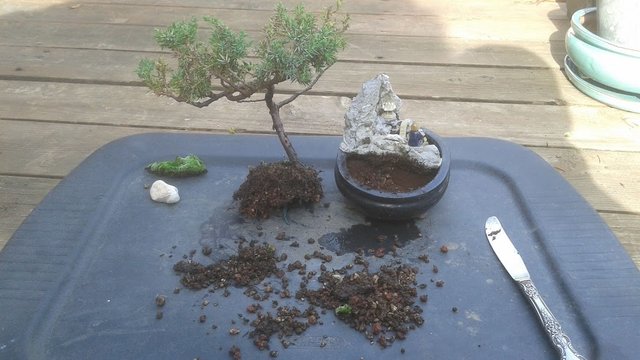
To uproot the tree, I slid a kitchen knife around the edges of the soil to loosen it from the pot. I try not to use any aggressive force when removing the tree, because it could snap the tree in half. With a little patience, the tree slides out free from the pot with most of the soil and roots still in-tact.
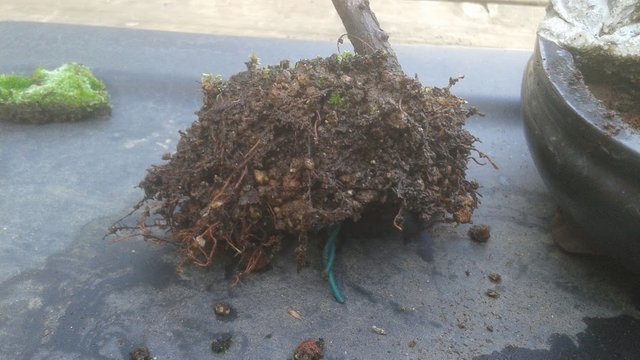
The old wires used to secure the tree to the hole in the pot are still visible. To really examine the health of the tree, I decided the comb out the roots a bit with a hand rake. I cannot see any signs of a developed nebari (base roots closest to the trunk, on bonsai these are meant to be visible above the soil line) unless I dig a little deeper.
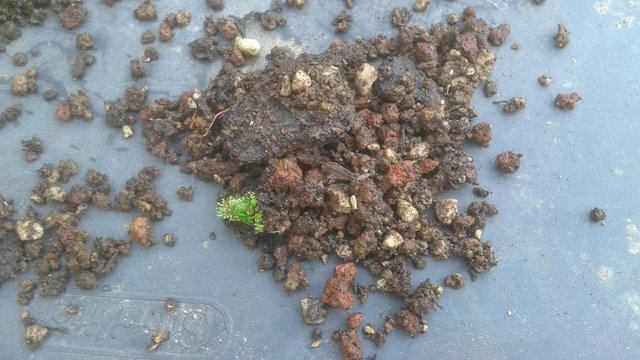
The old soil that fell off looks to be of very poor quality for a bonsai juniper. Moss, peat, decomposed pine bark, and black dead roots have formed a sort of black slime around the root mass. I can also see pumice and lava rock, which are doing well to help wick the water away, but clearly not good enough.
The golden clay balls that match the color of thew new pot, this is akadama clay, which is ideal for most bonsai. Akadama clay, like pumice stone, also has porous properties made through volcanic processes. This rare clay has microscopic tunnels to help feed crawling roots, and it snaps into smaller particles as the roots grow thicker. Akadama clay is a brand that can only be purchased and shipped from Japan, and in some years it cannot be purchased at all from overseas. Rumor has it, clay with properties almost identical to Akadama has recently been discovered near Mount Hood in Oregon. Bonsai enthusiasts are all clambering around here trying to find a retailer who sells it. Others, I kid you not, keep such information a carefully guarded secret, believing they can profit or gain by being the only people with access to it. But that, is another story...
Akadama clay, as I later learned this past year, is NOT good for juniper. It will kill the roots. I am not sure why exactly, but that is what the experts in my region have all agreed. I'll be removing as much of the akadama as possible, without disrupting the main root ball too much. My goal this time is not to reduce the size of the tree or roots, but to expand it.
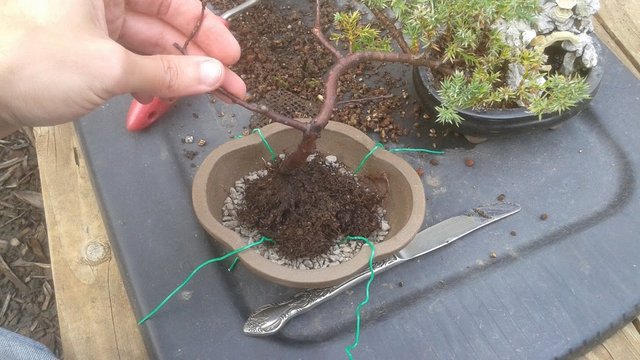
Next I place the tree inside the pot to see how it will fit. One of the longer roots was so long that it was folding up against the edges of the pot. Those roots will be pruned to fit.
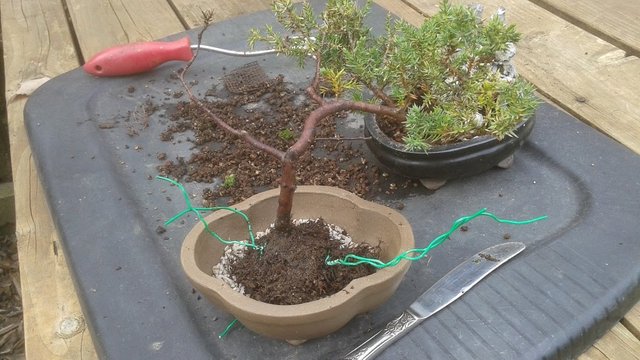
Using pliers, I twist the wires to secure the tree into the desired position. I am slightly aggressive with the pliers to make sure the wires are very tight, but not so tight that it will snap and cut the roots. I forget the old saying, it's something like "Weak roots make a weak tree. Strong roots make a strong tree." Sounds like something Mister Miyagi would say.
With the tree secured, and still most of the roots still unrestricted by the strangling wires, this tree will have lots of volume for the roots to grow healthy.
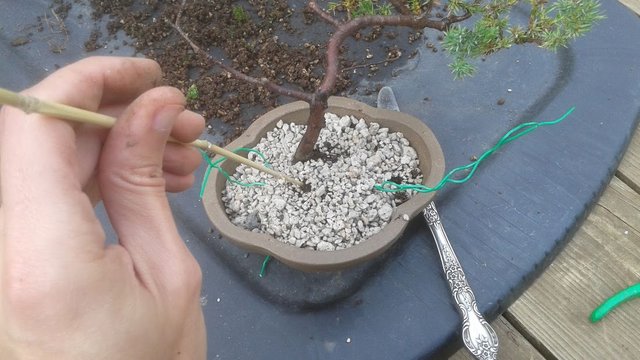
An old bamboo reed I found in my tool chest works great as a chopstick, because it is long, smooth, hard, and flexible.
I use the chopstick to press the gravel soil into the air pockets underneath. By forcing the pumice into the roots, I am cleaning the roots of the old slimy soil, and replacing those pockets with better draining soil. The stones will also make microscopic cuts against some of the bark on the wood, triggering the exposed cambium layers to form fresh new roots that will latch onto the rocks, further strengthening the tree.
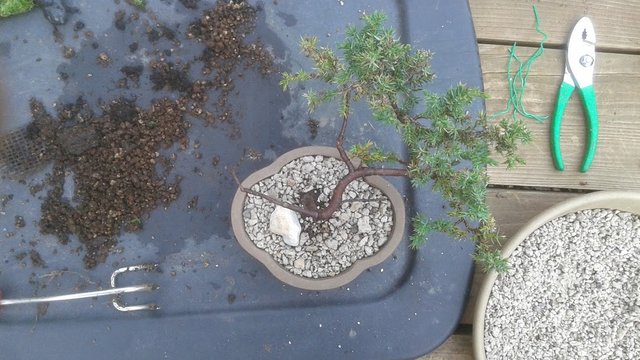
The new clean soil looks so much better. This bonsai is now vacationing inside a new alpine desert scene. The white accent rock also matches the new soil. One reason I like using a decorative accent rock on top is because it makes the tree look more proportionate. Take away the pot from the field a view, and it looks like a full-sized tree growing beside a sun scorched boulder.
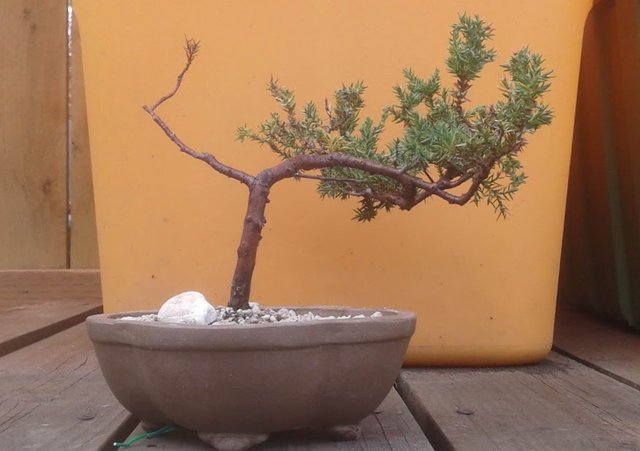
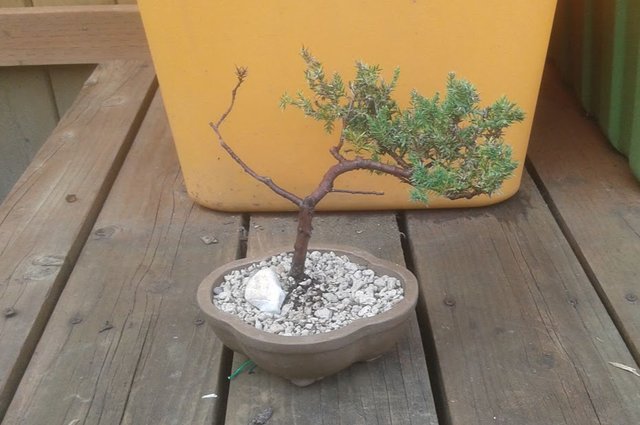
The red tarnished wood of juniper almost looks like copper wire to me. The old yellow bristles are signs of the tree's stress, possibly from the recent frost and the excess rain and poor drainage around the root zone. Some might say this tree isn't receiving enough nutrients, and that could be the case. Often a tree will not absorb enough nutrients if the roots are diseased or rotting.
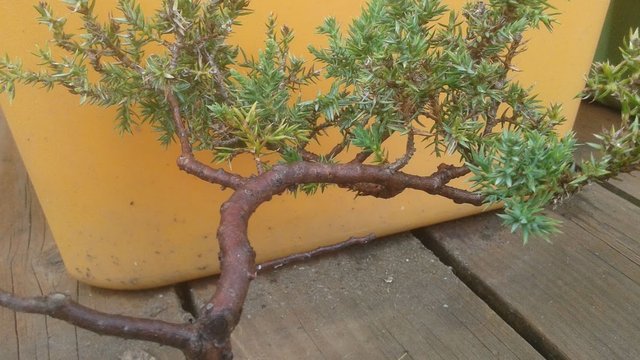
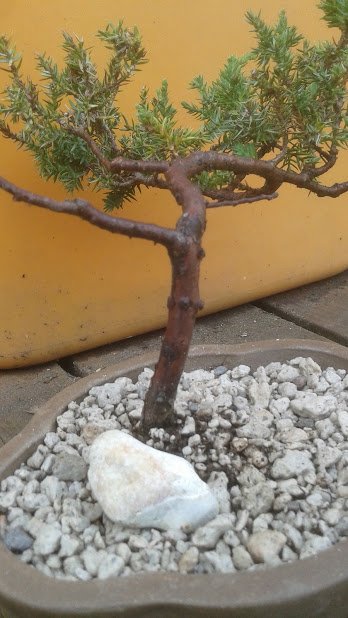
Old knots in the wood give this tree the characteristics of age.

'Tis a shame that I have to put this tree away now for the next four to five months.
Put your toys away for winter. In Spring they will need lots of a love and care. By Summer, the strongest trees will grow in value!
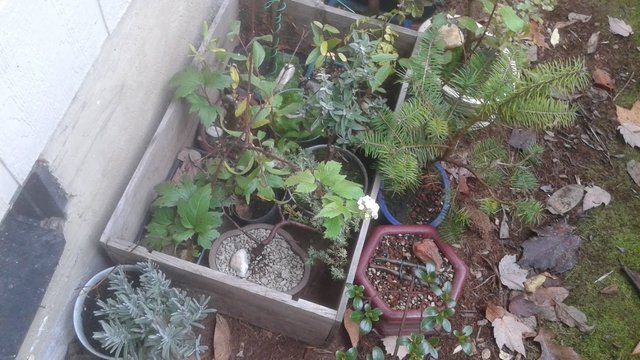
I pack my trees in tightly under the eaves of the house, and bury them with a blanket of coconut coir and wood bark. This is the last photo opportunity before they are buried.
Bonus Photo
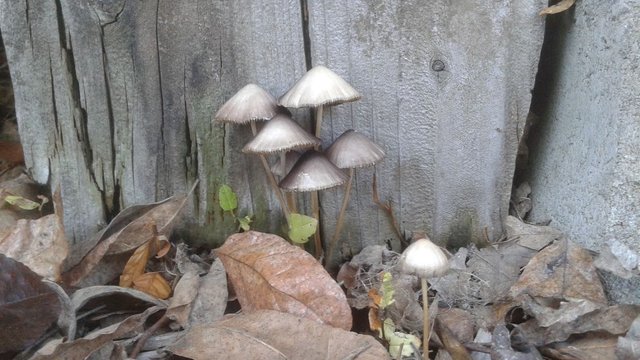
At first I thought this was some kind of toadstool attached to the wood boards. Nope, just a regular five story mushroom kingdom. Gnomebody here.
Photos in this post are all #originalworks by @creativetruth, unless stated otherwise.
Find me on discord and chat with other tree growers, bonsai enthusiasts, and gardeners. We have quite a few accredited experts filling out our ranks, and a helpful Spanish-speaking community.
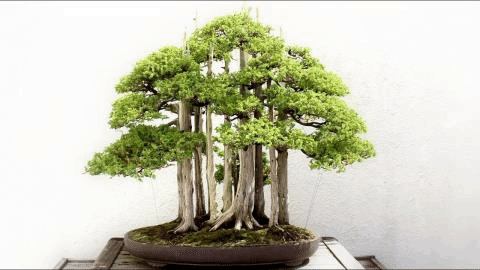
Bonsai!

| Account Value: $1,414.62 | Votes Given / Received: 4,161 / 10,323 |
| SP: 1,843.974 | Posts / Comments: 249 / 1,911 |
| STEEM / SBD: 0.754 / $7.09 | Delegated In / Out: 187 / 180 |
| REP: 63 | Followers: 1,634 / 196 following |
| Curation Rewards: 1.671 SP | Author Rewards SP / S / SBD: 1.389 / 0 / 0.016 |

| STEEM In / Ex = 0.762 / 0.74189 | BTC / ETH/ LTC = 6457 / 213 / 51.6 |
| SBD = 0.97365 | Gold/Silver oz. = 1,210.50 / 14.20 |
Level Up!
Reputation of @creativetruth is now 63.
Much thanks to my old and new friends. Thank you for helping me grow!

Great post! I love all the details and photos. Makes me think in my head I am a bonsai master ha ha This is a very attractive bonsai. Be interesting to watch the bare branch now that it is repotted. btw here is what I think of for Allison
I love this song for dancing Nightclub Two-Step. So soulful and relaxing.
A very informative post and I was kind of hoping there was some secret technique you had used when re-potting your Juniper. I've been having some trouble with one of my two year old junipers lately. Following a re-pot two weeks ago, the young one has lost all of the colour in its foliage which eventually turned a brownish white. I checked for spider mite but no, nothing.
I thought that the growing medium was wrong but it is the exact same mix I have been using for all of my junipers but only this one has given me grief. Peat moss, river sand and tiny river stones and they only get watered once per week - thorough soaking. Foliage is misted once every second day.
I've taken to removing all of the discoloured foliage yesterday and placed the tree back in the shade and am keeping tabs on it for any signs of further change. A scratch test showed that the tree was still very much alive.
The roots were also kept moist during the re-potting and no major root pruning was done. Since junipers don't like that much fertiliser, I also used very little.
Maybe just give it time and see what happens?
Cut down on the watering, and keep the humidity high if you can. I used to keep my juniper sitting over a water dish or a fountain, or near grass to help keep the foliage from drying out. Where I live, people recommend lots of fertilizer for juniper, but they use mostly organic fertilizer. Everyone seems to recommend different things, so go with your gut.
Luckily it is always humid here. Will definitely start watering less. Thanks for the advice.
wow bro! the delicacy...of your art! absolutely amazing!!!!! i'm so drawn to this work with bonsai. mesmerized. do you recommend any particular docs. i watch any i can find!!!!!!!!! you...my friend..inspire the crap outta me!
There are a lot of great library books, with pictures! We all wish we could have a master mentor, but you don't have to be a master to get started. And personally I think it's more fun to just knowing the basics of soil, potting, watering, and pruning than to follow all the strict design rules.
I love that you named her....Allison. :)
Congratulations! Your post has been selected as a daily Steemit truffle! It is listed on rank 5 of all contributions awarded today. You can find the TOP DAILY TRUFFLE PICKS HERE.
I upvoted your contribution because to my mind your post is at least 6 SBD worth and should receive 152 votes. It's now up to the lovely Steemit community to make this come true.
I am
TrufflePig, an Artificial Intelligence Bot that helps minnows and content curators using Machine Learning. If you are curious how I select content, you can find an explanation here!Have a nice day and sincerely yours,

TrufflePigI like this kind of pots: those ones are similar to clouds and I feel light when I see them.
Cool!👍
Posted using Partiko Android